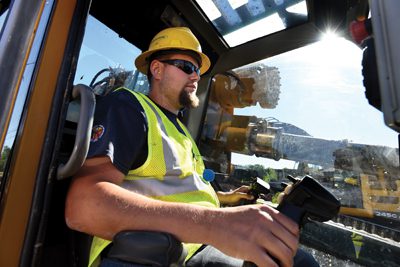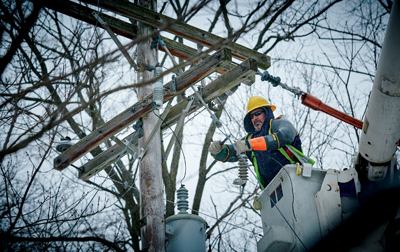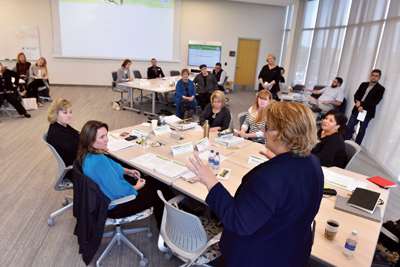
It’s no small problem that demands no small solutions.
The issue is one faced by an increasing number of businesses, including manufacturers, companies that provide essential services (think of the various tradespeople who build what’s needed and fix what’s broken), as well as those with the skills to build, maintain and expand networks and other internet-based services that drive much of our economy.
We’re talking about the imbalance between the people needed to fill those jobs and the numbers (growing with no sign of slowing down) available to keep our economy on track.
Call it what you will—the talent gap, the skills gap or any other label—it’s real and the topic of conversations in recent years that keeps getting louder and with an increasing sense of urgency.
Thankfully, however, there’s evidence that the talk is translating into action.
A strategy emerges
One significant piece of evidence is the State of Michigan’s Marshall Plan for Talent, a comprehensive, multiyear strategy meant to fundamentally change the imbalance dynamic that businesses have been shouting from the rooftops for years.

Now established in state legislation, more importantly some $100 million has been set aside to drive solutions to a problem that Governor Rick Snyder, whose term-limited tenure ends in December, has seen grow with the rebirth of the state’s economy.
“As I travel throughout the state of Michigan, the question I hear most often has changed dramatically, from ‘where are the jobs?’ to ‘where is the talent?’”
At the same time, Snyder and a team from the state’s Department of Talent and Economic Development saw a real opportunity: bring everyone together on the best approach to match educational skills with available well-paying jobs.
For people like Sharon Miller, who serves as Michigan Talent Architect for Consumers Energy, it’s an approach that’s already driving value for the energy services giant in both the short and long term.
Charged with keeping the lights on and providing heat to its 1.8 million electricity customers and 1.7 million gas customers, Consumers Energy needs a steady flow of highly skilled workers to accomplish its mission, of which Miller is keenly aware.
It’s one reason Consumers played a key role in creating the Michigan Energy Workforce Development Consortium, teaming up with the state and more than 50 energy sector companies facing the same challenges.
Out of that initiative, Consumers Energy developed what Miller calls direct pipeline arrangements with two schools—Lansing Community College and Alpena Community College—in developing line worker training programs that are starting to bring the company the people they need and want, a classic win-win for everyone involved.
“It’s been a longstanding problem for us, so it’s a pretty big success for us,” said Miller.
Roger Curtis was instrumental in bringing the state’s Marshall Plan to reality in his role as director of the state’s Department of Talent and Economic Development, a role he began in November 2016, having previously served as president of the Michigan International Speedway for 10 years.
“We knew we had a talent gap in the state and as the governor and I discussed it, we knew the focus had to be on education,” said Curtis, who becomes vice president of public affairs for Consumers Energy shortly before state voters pick the successor for his term-limited boss.
Even during discussions around Michigan’s running in the race to become a second home for online retailer Amazon, a quest that ultimately fell short, a consensus was beginning to develop.
“We realized that the scope of the talent issues went well beyond what was needed to convince Amazon to come to Detroit and Michigan,” said Curtis. “We were going to have a shortage of workers and we realized we had a lot of work to do.”
Curtis talks about taking a revolutionary approach to the problem, one focused on building capacity for the jobs of today and tomorrow.
With the “Marshall Plan” analogy borrowed from the U.S. post-World War II rebuilding effort in Europe, Curtis and his team began to assemble the pieces necessary to build traction.
“A lot of it we recognized quickly,” he said. “One of the realities is the fact that technology has changed every facet of business and the pace of change is only going to quicken over time.”
And while Curtis saw “some amazing best practices” when it came to ways companies had been able to grow new talent in their organizations, what was missing were the systematic and consistent talent training systems that would scale throughout the state.
Part of the problem lies in history: how a 200-year-old system that was built on getting farmers to work in a factory differs from the current needs of business.
“Training today has to be based more on collaboration and communication,” said Curtis. “It’s about how you take the knowledge you have and become lifelong learners. That’s the aspirational piece that is part of what the Marshall Plan delivers.”
Coordination, communication is key
People like Andrew Weaver, assistant professor at the School of Labor and Employment Relations at the University of Illinois at Urbana-Champaign, have weighed in on the issue from an academic standpoint.
Weaver, who received his doctorate from MIT, challenged the idea that American workers are being “left in the dust” because they lack technological savvy.

Energy is shown driving equipment for a natural gas pipeline project, another job for which the energy firm is keen to recruit.
In “The Myth of the Skills Gap,” which appeared in the MIT Technology Review, Weaver argued that the focus should be on coordination and communication between workers and employers.
Weaver sees two significant problems related to the talent gap.
“One is that when we look at the situation, measuring the skills, most of the analysis is based on measurement of actual skills, but they aren’t going in and measuring what’s required,” said Weaver in an interview. “They’re backing into it and making the assumptions.”
A second issue, Weaver says, is a lack of understanding when it comes to the demand side of the talent equation.
“It’s not necessarily that (employers) won’t get the skills,” he said. “It’s just not clear what skills are critical.”
Weaver adds that exhorting students in a local market to get more education isn’t particularly helpful.
“You’ve got to have various institutions that keep the supply/demand in balance,” he said.
Which brings us back to what folks like Sharon Miller at Consumers Energy are up to with their partnerships with community colleges in Michigan.
Understanding the challenges
“We’re being proactive in a very significant way,” said Miller, alluding to a focus on not only Consumers Energy’s brand, but its relationships with schools with which it works to provide training.
But there are also challenges, many of them centered on the sheer scale of the relationships that people like Miller need to manage.
“We have 52 headquarters in the state of Michigan, but it’s also important for us to be clear on what our hiring needs are going to be, to connect with recruiters, with human resources people, with hiring managers and those who manage the relationships with the schools.”
Miller also acknowledges that those schools have challenges of their own.
“Resources are tight, there’s accountability in adhering to standards that are set by others, and even the traditional school year timing, all of which need to be considered.”
If that sounds daunting, maybe even beyond the scope of what’s possible, Miller steps back with what could be said to be calming words.
“I don’t want to make it sound like those challenges are insurmountable,” she said. “It’s about understanding the challenges on both sides.”
For example, Miller points to a course on energy industry fundamentals that’s currently being taught at either a community college or to high school students at the junior/senior level.
“As we’re working with the schools to implement this course, they tell us it will be an elective,” says Miller. “We’d like it to be a science course. It’s a conversation that’s just beginning, but our goal is to make it more widespread in high schools and not just for career tech students.”
Still, Miller is seeing progress, especially as at least some of the urgency gives way as the state’s Marshall Plan approach becomes clearer.
“A lot of what companies have been facing is this: they see a burning house and we’re talking about fire prevention,” said Miller. “With the energy companies, we are getting past the burning house and now we’re doing more fire prevention.”
Looking past today’s need
Miller acknowledges the balance that’s needed.
“It’s that immediate need that keeps you focused on today, but sometimes it prevents companies from getting involved in the long term and you need both.”

With the state of Michigan focused on the reality of huge numbers of high-demand career openings emerging through 2024, there’s an even bigger number to get our attention: the $49 billion in potential earnings those 811,000 jobs represent by the time 2024 rolls around.
Other initiatives are either underway or soon to be.
They include partnerships announced in May between Davenport University and the City of Detroit and Wayne County, providing scholarships to employees in both jurisdictions, both through Davenport’s Institute for Professional Excellence.
At University of Detroit Mercy, the school is aligning a cybersecurity curriculum with new industry guidelines to prepare students for the growing job market.
That move follows the designation of UDM as a Center for Academic Excellence in Cyber Defense Education by the National Security Agency and the U.S. Department of Homeland Security.
The SME Educational Foundation and the Michigan Manufacturers Association have teamed up to make available educational opportunities for students of Fraser High School. Several companies, including Dominion Technologies Group, I.F. Metalworks, Fori Automation, General Motors, Oakley Industries, and Superior Heat Treat LLC are involved through SME’s Partnership Response in Manufacturing Education initiative.
In November, as many as 10,000 students from area high schools are expected to take part in MiCareerQuest Southeast. The event aims to connect students from Oakland, Livingston, Macomb, Wayne, and Washtenaw counties with working professionals from nearly 100 companies throughout the region. The students will take part in hands-on, interactive demonstrations and conversations that highlight in-demand jobs in advanced manufacturing, construction, health sciences and information technology.
In Oakland County, a partnership with Henry Ford Health Systems and local colleges will see the region’s first medical assistant apprenticeship program.
That announcement, made in April, recognizes that medical assistants are in the top 10 in-demand jobs in health care and puts in place an apprenticeship program that addresses a significant shortage.
Competency-based learning
Roger Curtis wraps up a conversation on what the Marshall Plan for Talent will mean for the state, even as he himself transitions to his new senior public affairs role at Consumers Energy.
“It’s about how we move to a competency-based learning system,” said Curtis. “We want people to be able to master competencies.”
At this point, he draws attention to the results of a survey where various executives were asked about their organizations’ needs in the IT area, what training levels were required and so forth. What the executives said was that a certificate would represent the bulk of their need.
“Then we went to HR and they told us that they needed a bachelor’s degree for all of them,” said Curtis.
“What we’re now trying to do is get the message out that it’s not about an ‘either/or’ proposition: either you go to college or you don’t. It’s about turning students into lifelong learners, wiring their brains to take on critical thinking.”








